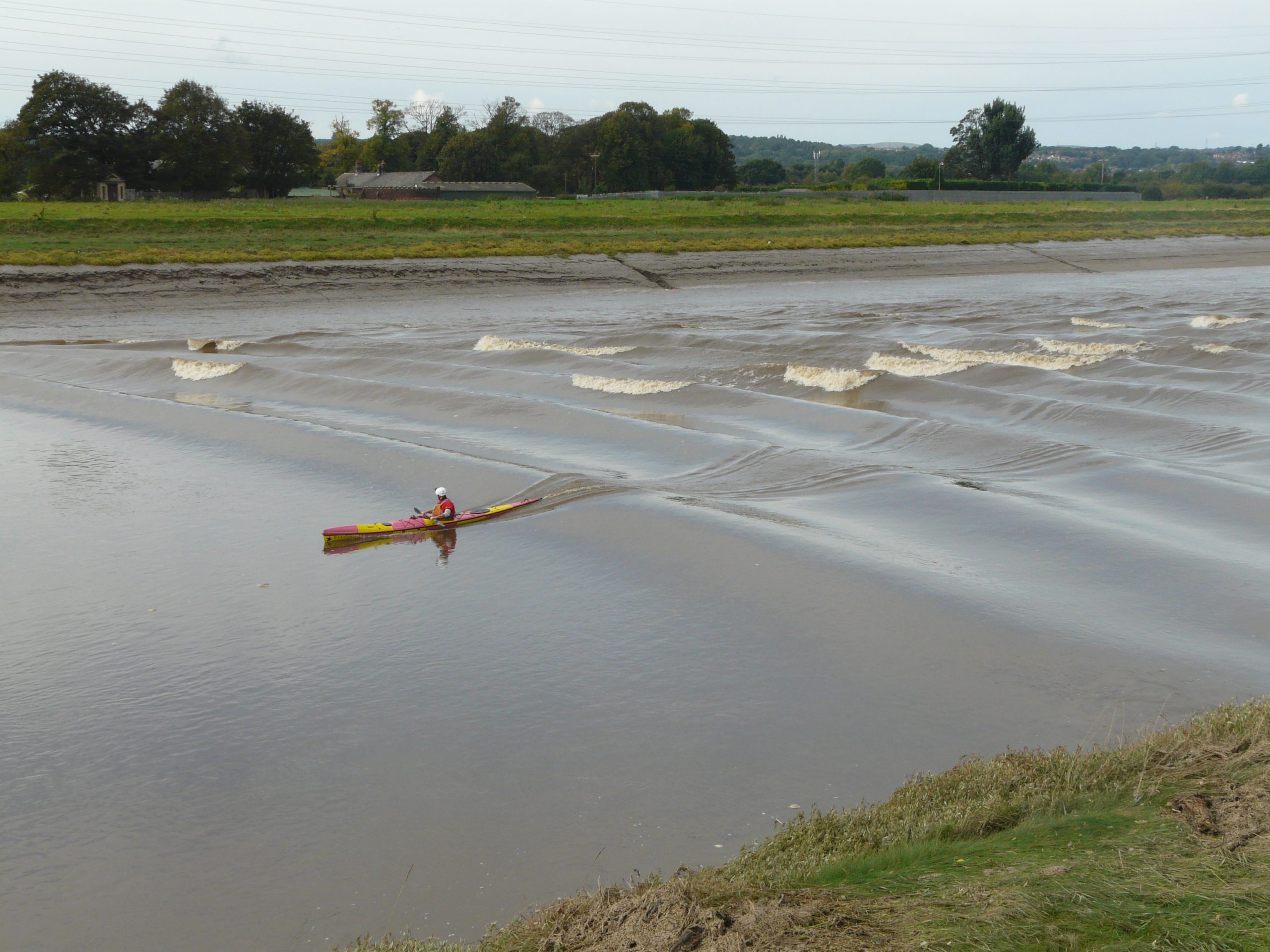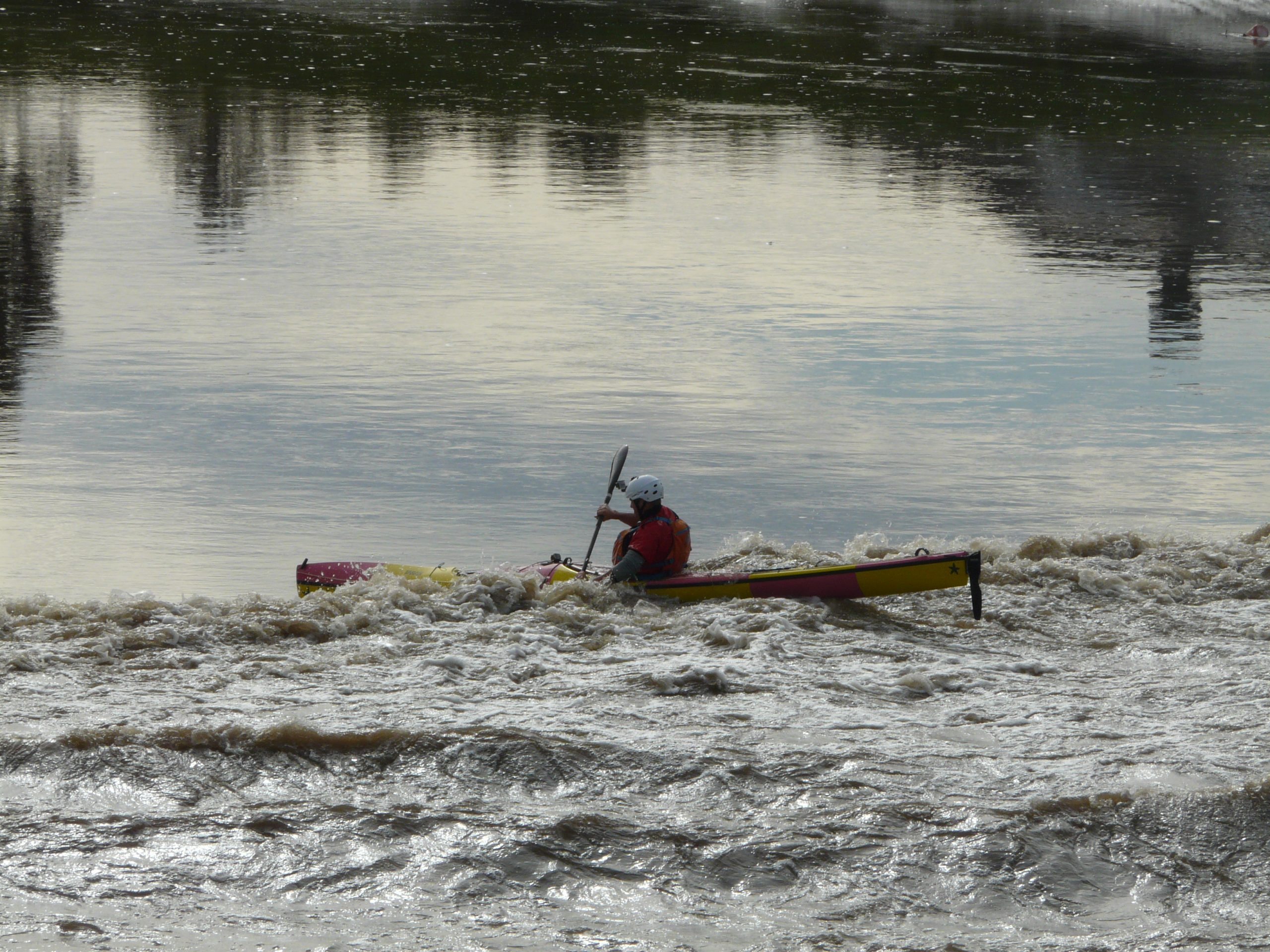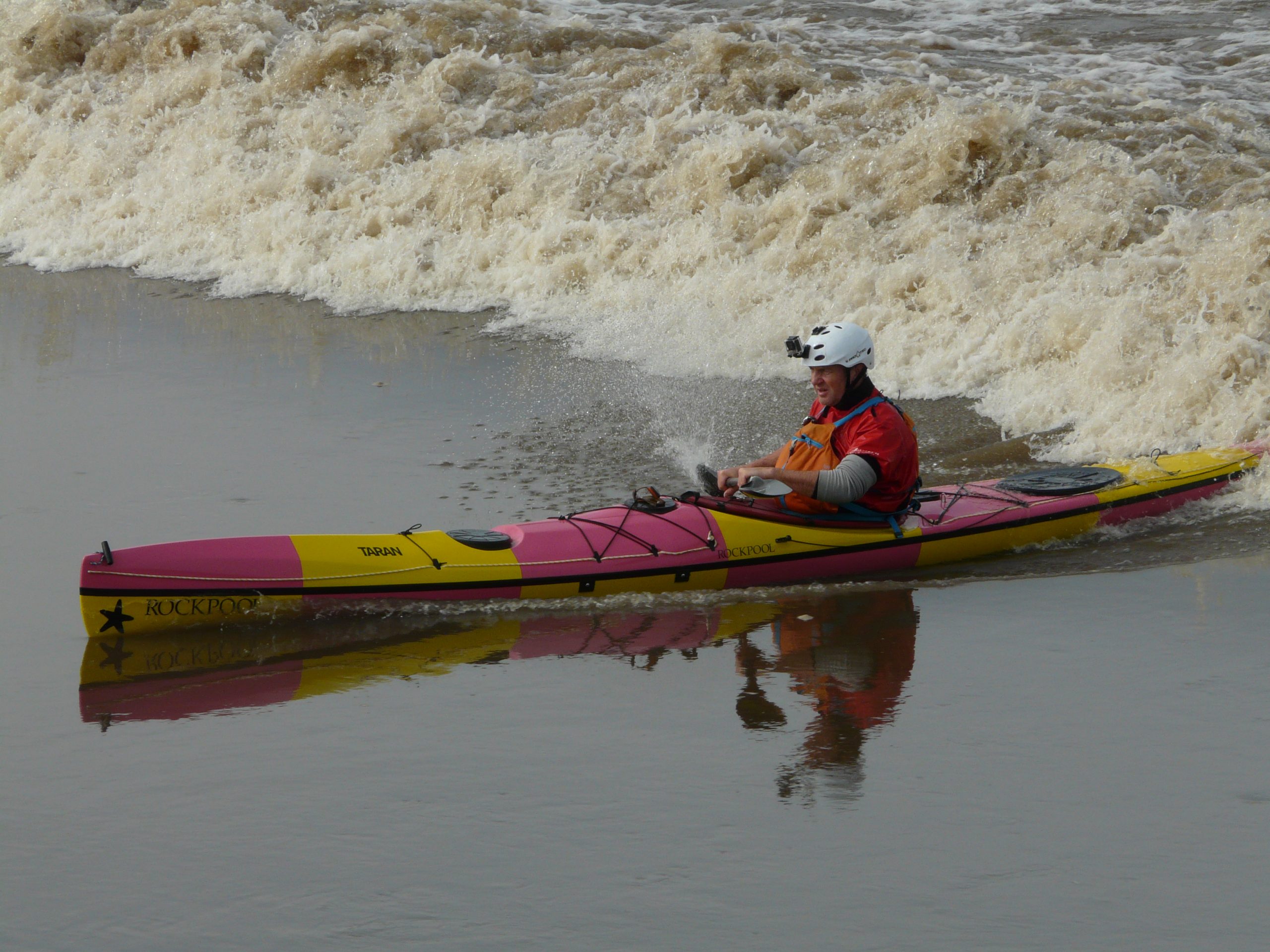Pull up a chair, it’s a long one…
I was asked about the effectiveness of the rudder during/countering a bongo slide while riding the River Dee Bore:
“Does the rudder have any effect to help escape the bongo?”
Well, no, not really. Let me try to explain.
The Rudder
As the boat moves forward the effective flow of water runs longitudinally along the hull of boat. At the stern it passes along the chord of rudder blade (i.e. from front to back). As you change the angle of the blade to the water (using the footpedals), the water is deflected sideways. This sideways deflection causes an opposing lateral force on the stern of the boat, making it move sideways. The stern hinges around the longitudional centre of paddling pressure, so as the stern moves one direction the bow moves in the opposite direction. The boat turns.
Still with me?
The important point to take away is that you need a longitudinal flow of water along the rudder blade (from front to back) for the rudder to work. No flow, no turn.
To the video:
When the boat is ahead of the wave, with the bow pointing and moving upriver, the effective flow is longitudinal along the hull, from bow to stern. The rudder works as advertised.
However once the boat is sideways on to the wave, stuck in the bongo, any hull flow is limited and lateral across the hull i.e. it moves across the boat from one side to the other – in the video you can see the water appear on the upriver side of the boat after it passes beneath the hull.
Importantly, the flow at the rudder blade now also goes at 90 degrees across the blade. As there is no flow along the chord of the rudder blade, it produces no useful steering effect. Push the pedals all you want, the rudder has left the party. You are going sideways, like it or not, until the wave goes green or you do something to get off it.
(Even if the rudder had useful flow along it, the square cm’s of surface area would be unlikely to overcome the force of wave pushing sideways for the length of a 5.5m hull)
So how do we get off?
If you watch the vid you can see 3 phases to my bongo, it is subtle but they are there.
First I just sit, let the boat settle, get a feel for it, catch my breath and try to relax as I work out my options. My strokes are nothing more than support strokes.
Then, I paddle tentatively forward a few strokes. I want the bow to start moving down the wave a little if I can, this begins the correction. (It also gives me a little more space from the bank – the wave feeds in that direction).
Next I push my paddle forward (@ about video: 20 secs) and hold it in to what is a sort of bow pry, ahead of my body. You can see the blade has moved from level with, and away from the body (best support) to forward and close to the boat.
What I am trying to do here is use a constant pressure to push the boat back up the wave, enough to release the stern. I need to push the boat up at an angle, to minimise the effective length (so there is less for the wave to hold) and so it is stern first. It is important that the stern goes up the wave first, not the bow, or I will be pointing downstream at the end of the manoeuvre. Then I lose the wave.
Once the stern frees you can see it is quite easy to turn the bow upriver and paddle down the wave. (Yes, it would turn even easier if I lifted the rudder, but I’m not inclined to let go of my paddles during the bongo. There’s quite a lot at stake.)
The move requires a constant pressure and the blade stays in the water, rather than strokes, for a number of reasons:
One it still gives me support (watch for ‘sinking wings’ though).
Once the stern is released I can quickly turn the stroke into a forward stroke and off down the wave we go.
If I pop off the top too fast, pointing across the river, I will lose the wave. So it also gives me the option to change the stroke to just push the bow back down the wave – to try again if I need too.
There we go.
So all in all: no, I don’t think the rudder helps to overcome the bongo.
A couple of Bore Riding points of interest:
The video bongo:
As the wave approaches, you can see me make an effort to avoid the initial broach, but it is a little half-hearted.
For a couple of reasons:
One, I’m resigned that it’s coming, and a little nervous. It’s easier to give in and get on with it somehow. Not a great approach but that’s the truth.
More significantly though: I want to choose which side I bongo on. If I fight the broach harder it is a bit of a gamble where I end up. So if I accept the broach early, I choose which side to sit on.
That’s useful for a number of reasons:
I’m happier on my RHS on the whole.
I am close to the river bank on my left, I want a bit more space between me and the rocks. I also need room for the correction, it is effectively a turn and needs a little space. So as it’s nearly always easier to sort life out going forward rather than backward, I choose to point right.


Bore Characteristics
The bore wave has 3 main phases or characteristics:
Green wave:
There is a front wave with a set of troughs and waves behind. The waves get smaller the further back you are from the front wave. Surf it like a normal green wave. Keep it straight and smile.
Broken wave:
same as above – waves and troughs, but with white broken sections on the waves. Not really a great drama, surf as per normal, but bear in mind that a long boat on the shoulder of the white may go into a full broach quickly without giving a monkey’s where you want to go. You are likely to lose a lot of time if you broach, and watch the front wave move rapidly away. Serious sweaty work, or disappointment then follows.
The Wall:
This is different.
Here what looks like a broken wave (usually full or much of the river width) has no trough behind. The water surface is horizontal and at the same height as the top of the wall. Rather than a wave moving upriver THROUGH the water, this is actually the front of the incoming tidal flow moving upriver i.e. a block of water moving upriver.
Here is the significant bit, the water behind the face is moving upstream at the same speed as the face (whereas for the green wave, the wave/trough is moving upriver THROUGH the water).
So when you try to surf this wall the bow of your boat is moving through the water (at 5-6kts say) while the stern of your boat (behind the wall) is in water that is moving at the same speed as your boat i.e. effectively 0 kts.
So in effect your boat is shortened by half(ish) and you’ve been moved to the very stern. Directional stability becomes twitchy and broaches happen very quickly. And if you are paddling a ruddered boat, the rudder now has NO flow over it. i.e. it doesn’t work.
So this is why, when you see the wave go full width white on my bore videos, you will usually see me paddling to stay ahead of it. So the full hull and rudder stay in useful flow.
As you ride the bore upriver you need to alter your position in relation to the wave to match the change between wave and wall – sometimes on and sometimes ahead of the bore front. Brief examples of this on the Dee Bore Rocks vid.
So there’s a bit more to the bore lark than just pointing upriver and leaning back.
John Willacy
Dec 2022


